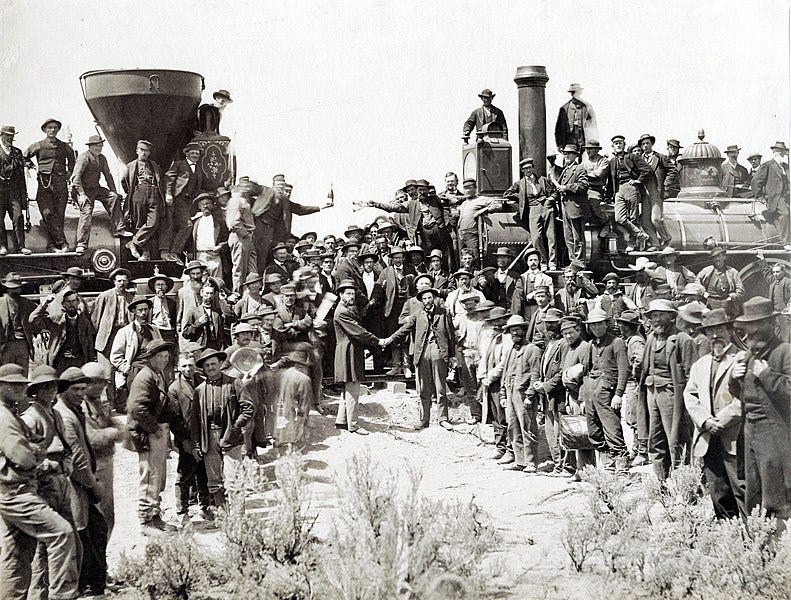The Central Pacific Railroad-building Ambition Was Fanatical If Not Foolhardy
The building of the Central Pacific Railroad had to be one of the most grandiose railroad-construction schemes ever concocted.
So what made it so? That’s the question.
The Backstory
Publisher’s note: You may want to jump ahead to the next section if you already know the history behind the effort.
To set the scene, the story opens with the construction of the Sacramento Valley Railroad (SVRR), which connected California’s capital and Folsom located 23 miles to the east.
Now enter Theodore Dehone Judah, who at just 27 years old and an engineer by training, had chalked up one major construction win already; he and his forces forged a railroad through a defile known as the Niagara Gorge.* He was the right person at the right time to see to it that the job got done and was done right and owing to that prowess, Judah was sought after to build California’s first railroad, the SVRR, which was chartered in 1852.
Hired in 1854, Judah, along with his wife, set sights on — and set sail for — California. The Sacramento Valley Railroad was completed in August of 1855.
Judah was not the kind of person to rest on his laurels. He got it in his head that building a railroad between Sacramento and Nevada’s Great Basin around, over and through the hard-granite Sierra Nevada ridge was doable. It was part of a much bigger dream to tie the continent together with iron rails reaching from the Atlantic to the Pacific.
Personally lacking the capital needed, Judah then went about rallying support for his grand (some might say grandiose) vision. It was through an extensive search that this visionary was able to find and secure the funds to make his dream a reality. And, just who did this enterprising young soul who refused to take no for an answer get to agree to buy in? The “Big Four,” they being Sacramento merchants Charles Crocker, Mark Hopkins, Collis P. Huntington and Leland Stanford.
The quadrumvirate’s motivation for backing the venture, however, was less than honorable. Their interest in this undertaking was for purely personal financial gain. What these fortune-seekers really had up their sleeves was wealth that could readily be attained from the veins of silver extracted from land just beyond California’s eastern border in the state of Nevada. Judah’s and the Big Four’s motivations could not be more different and that led to the now two opposing sides cutting ties.* Bygones being bygones each side moved on.
Happening alongside all this was the signing by President Abraham Lincoln of the Pacific Railroad Act in 1862, that key piece of legislation allowing for the Central Pacific Railroad’s formation. Curiously, though, the railroad’s incorporation occurred on June 28, 1861, 163 years ago almost to the day! Construction, meanwhile, commenced roughly a year-and-a-half later in California’s capital on January 8th.
Hard Work, Big Payoff
Practically right out of the starting gate, a formidable opponent was faced, this in the form of the mighty Sierra Nevada ridge.
In some locations, tunneling through solid granite proved to be among the most arduous of tasks. In some situations, that work took literally years to complete. What should not be lost sight of is that railroad building in the mountainous terrain was not without its risks. It fast became clear just how dangerous said work was evident by the sheer number of worker deaths. Handling the explosive materials, materiel used for blasting away rock to make rail right-of-way shelves and holing through tunnels in the filled-to-the-brim-with-granite earth, was often an iffy proposition. Imported Chinese and Irish labor contributed significantly to the building effort.
Coming off and out of the Sierra Nevada Mountains, meant the harder work lay behind. What work lay ahead across the dry Nevada expanse was by no means simple, but by any stretch of the imagination was nothing akin to what workers already faced in comparison. If it hadn’t been earlier, it was now full steam ahead.
Transcontinental Success!
No single person can dispute the historical significance of Central Pacific’s contribution to the American West. For four long years, Chinese and Irish workers toiled exhaustingly as they dug and blasted their way through the granitestone over the same pass that claimed the lives of half the 87-member Donner Party during the winter of 1846-‘47. Conclusion to this epic endeavor was marked by the driving of the golden spike, the successful completion of which sparked a nationwide celebration initiated by a singular telegraph message sent that the task was indeed, “Done!” This historic milestone is regarded as an achievement of monumental proportions, and that it took place during the latter half of the 19th century, speaks volumes!
Immigrants from every corner of the globe ascended on the northern Sierra Nevada mountains in America’s 31st state — California — to show to the world just what they were made of.
But, not everything between worker groups was always hunky dory. There were times when tempers boiled over. Violent physical altercation replaced heated verbal exchange, the outcome of which in many a case was loss of life and/or limb.
When all was said and done, however, in the Central Pacific railroad-advancing sense, the west was won. America’s very first transcontinental was completed on May 10, 1869 in Promontory, Utah. It was there that the railheads of the Central Pacific and Union Pacific (the partner railroad that had been building west from Omaha, Nebraska) railroads met.
And, that, after all, is what mattered most.
* Zauner, Phyllis, The Train Whistle’s Echo: Story of the Western Railroad Era, “Bold Vision … Or Madness?”, 1981, Zanel Publications, pp. 7, 8
Updated: Jul. 2, 2024 at 8:45 a.m. PDT.
Image data: Andrew J. Russell/Wikimedia Commons
All material copyrighted 2024, Alan Kandel. All Rights Reserved.




